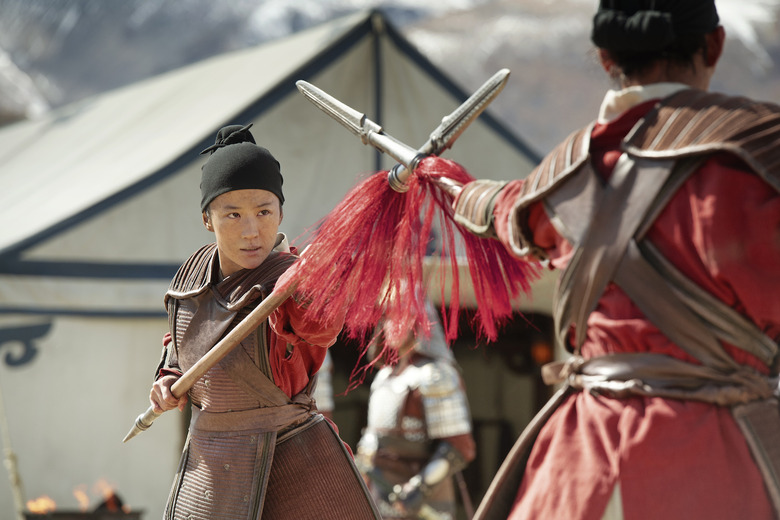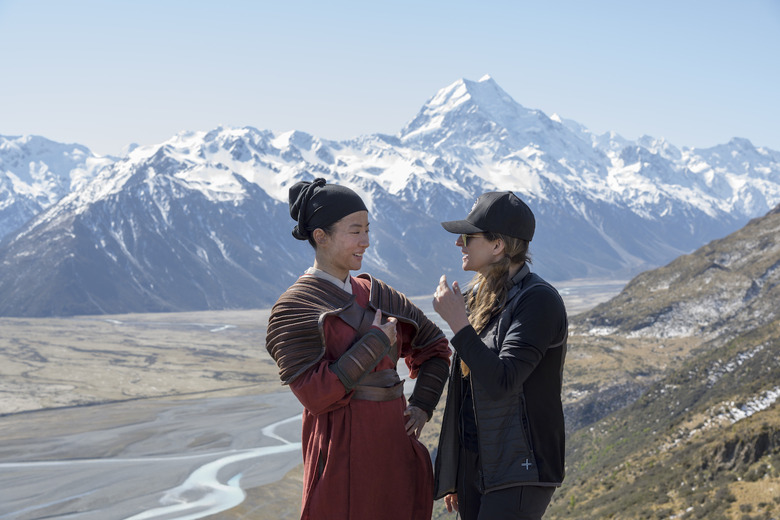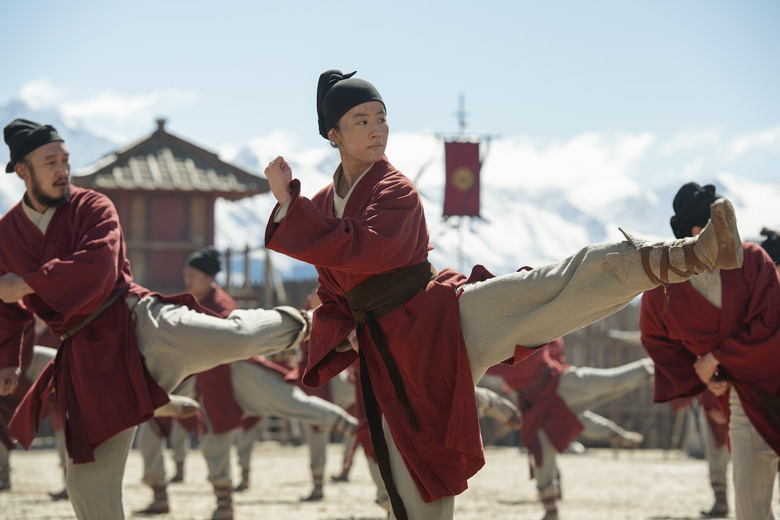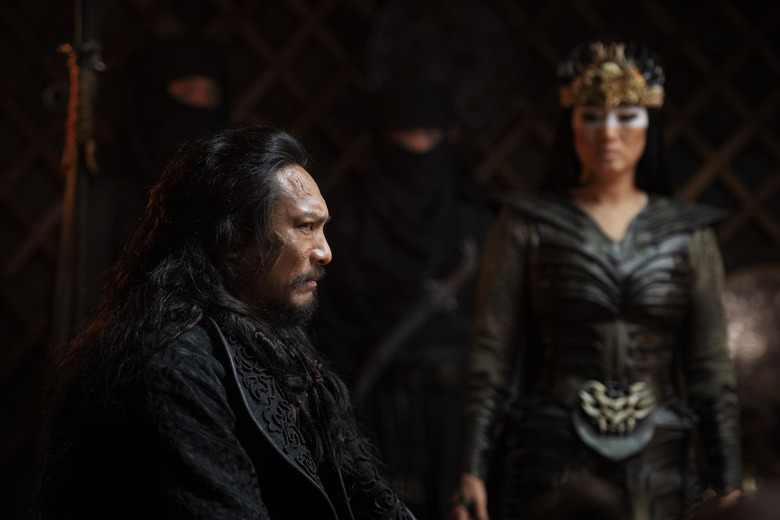'Mulan' Brings Honor To Both The Animated Film And The Chinese Myth [Set Visit Report]
Resplendently armored Chinese army generals sit atop horses in a valley nestled in the middle of a mighty mountainscape, fluttering yellow and red flags surrounding them and dust billowing in from a wind machine. Not that they need one — the natural wind of the New Zealand countryside acting as the Chinese battlefield on the set of the live-action remake of Mulan is strong enough. It's the kind of wind that blows through your hair until the separate strands cut into your face, and pierces through your coat to settle into your bones.
But Mulan star Liu Yifei is paying no mind to the wind, even as it whips her long hair around her face in such a wild frenzy that her eyes can barely be seen on the monitors. She's poised, stony-faced, her simple robe the one bright flash of red among the weather-beaten, dirt-covered soldiers who ready themselves to charge against the invading Rouran army, a battlefield strewn with dead horses and soldiers stretching out between them. Yifei is running through the climactic battle scene of Mulan: the zenith of the film in which the mythic Chinese warrior has now revealed her identity to the world.
Waiting for Mulan
"Yifei, she is just Mulan," costume designer Bina Daigeler tells a group of journalists visiting the New Zealand set. Kiwi director Niki Caro has taken the production of Mulan, the upcoming remake of the beloved 1998 animated film, to her homeland, where /Film was among those invited to view the film's big battle scene between the Chinese imperial army and the invading Rouran army led by Jason Scott Lee's vengeful warrior Bori Khan and Gong Li's mysterious taloned witch Xian Lang. It's a scene that was a long time coming, as the Mulan production had been delayed and the live-action remake's release pushed back so that Liu could step into the iconic armor.
"We waited for Yifei," producer Jason Reed says. "Once we went through that search and we determined that Yifei was the person we wanted and that she had the correct spirit and the correct determination and work ethic...we had to wait. We pushed production 5 months, which was interesting. Also the previous release date, if I'm totally honest that first release date was a placeholder anyways, and it was some ways intended to scare off anyone who wanted to make a Mulan movie."
There are certainly a lot of reasons to be scared to make a Mulan movie. The 1998 animated film directed by Tony Bancroft and Barry Cook was a beloved hallmark of the Disney Renaissance era and a cherished part of many moviegoers' childhoods. And while Disney live-action remakes are basically guaranteed box office hits, fatigue has set in for the nostalgic rehashes critically. But there's more riding on this film than the Disney label. Mulan is a famous figure in Chinese folklore stretching back centuries, with the original The Ballad of Mulan folk song dating back to the 6th century. China has released their fair share of Mulan feature film adaptations, including one that came out as recently as 2009, none of which have gained much traction in the States. But Disney nostalgia is a global business and the Chinese box office is one of the most lucrative for Hollywood — Caro and her team need to strike that perfect balance that satisfies both audiences.
"The traditional Disney audience and the diaspora Asian audience viewed [the animated Mulan] in one way and the traditional Chinese in China audience viewed a slightly different way," Reed says. "So we really dug in to try and make sure we that we were addressing both of those audience in a thoughtful way."
The differences Reed refers to mostly have to do with the zanier "Disney" aspects of the animated movie that are now some of the most beloved by Americans who grew up with the film. The fan-favorite character Mushu, played with wacky aplomb by Eddie Murphy, "didn't play very well with the traditional Chinese audience" where the dragon is a sign of respect, strength, and power. Depicting the dragon as a "silly sidekick" was near-insulting to Chinese audiences, who also mocked the scene of Mulan cutting her hair — an empowering scene in the animated film that was very in line with the grrrl power feminism of the '90s, but made no sense for Chinese men of the time, who wore their hair long.
"We thought about how we were going to approach this movie — and the world has changed quite a bit since the animated movie was made. So we went back," Reed says. All the way back — back to the ancient folk song The Ballad of Mulan, which serves as the main inspiration for the film. The Ballad of Mulan is a Confucian parable that highlights the importance of duty to family and country. The feminist themes of the story aren't actually present in the original (very short) ballad, which instead emphasizes the duty that every Chinese citizen has to the emperor, regardless of their gender. Mulan is seen as a symbol of virtue for her devotion to her family, and as such, has been upheld for centuries as one of the most beloved Confucian figures in China. Caro's live-action Mulan remake leans into those elements — adding a younger sister, as one example — while still keeping some of the modern, feminist (and even funny!) elements that make the animated Mulan such a beloved film. "This is based on the poem but also employing some of the visual elements of the original animated film," producer Barrie Osborne adds.
Confucian hero, feminist hero, national icon. That's a lot of pressure to put on Liu, a Chinese-American actress who has carved out success for herself in the Chinese film industry — even getting named one of the most bankable actresses in China. But Liu resolutely shoulders the burden of playing an icon in both cultures she hails from, telling us that she only looks at the human within Mulan, not the hero.
"Although everybody knows the name, and everybody has their own picture of her, but to me, the hero is so human," Liu says. "I think it's all beyond words. You have to feel it as a human being."
Bringing Honor to the Live-Action Remake
Liu is on the move again. Her long, flowing black hair seems to have taken on a life of its own as she dodges and weaves through the masses of Rouran soldiers. Suddenly the monitor we are watching the sequence on slows down to a snail's pace, and Liu is moving in slow-motion, the pillowy plumes of smoke rising in clouds behind her as she twirls and slashes her sword, her red robes the one bright piece of elegance amid the muddy green battlefield. Powerful. Majestic. It's enough to take your breath away before you realize, hey, this scene wasn't in the animated movie. Instead of the short choppy haircut that Mulan gives herself in the iconic hair-cutting scene in the animated film, Mulan's hair is long, and the Hun invaders have been exchanged for the more legend-accurate Rouran Khaganate and their ally, Li's mysterious witch. The epic battle scene, which feels plucked straight out of a wuxia martial arts film, is a new addition for the remake by Caro and screenwriters Rick Jaffa, Amanda Silver, Lauren Hynek, and Elizabeth Martin. But these changes haven't been made haphazardly to try to distinguish Mulan from the onslaught of uninspired shot-for-shot remakes.
"There's been a number of movies that have failed in their attempts to tell Western versions of Chinese stories, or vice versa," Reed says. "And so one of the things that was made clear to us from the very beginning was make a Disney movie. Don't try to make the Chinese version of Mulan because they've already made it several times. And they've already seen it."
Caro had the unenviable task of figuring out what exactly makes "a Disney movie" — essentially maintaining that balance of respecting both the Chinese audience and the nostalgic Disney audience — while creating something compelling. To help with the former, Caro had a council of Chinese advisors working with the team through the development and design phases, and bringing 25 different experts in various areas helping with design, costumes, makeup, architecture, and story. Stunt riders were brought in from Mongolia and Kazakhstan, while the vast majority of the stunt team is from China. The majority of the cast comes from the Chinese mainland, including Liu who, despite having dual American citizenship, has spent most of her career in China. Caro, a New Zealand-born filmmaker who won the directing gig after Disney initially sought out an Asian filmmaker, has stressed the importance of authenticity in her films based on cultures that are not her own, having crafted a female-led adventure story deeply embedded in a specific culture with Whale Rider, which follows a young Maori girl who aspires to be the chief of her tribe.
"I made Whale Rider, I saw that to be specific and authentic is to be universal, and I've continued to work in an identical way ever since," Caro said in an interview with The Hollywood Reporter. "As the projects get bigger, the more certain I am that cultural authenticity and specificity is the only way to approach my work."
Mulan gets more culturally specific than the 1998 animated film could have hoped to get (Disney sent its team of artistic supervisors on the animated Mulan to China for inspiration, but that was about the extent of it on the authenticity front). The live-action Mulan also makes a bid to better represent the diversity within China at the time, which, according to star Yosan An, who plays Mulan's fellow recruit and love interest Chen Honghui, is inspired by the Tang Dynasty, an imperial dynasty that ruled between the 600s to 900s. During this time, the borders to China were more open than ever thanks to the Silk Road — opening the door for Mulan to feature South Asian characters like the one played by Pitch Perfect's Utkarsh Ambudkar.
"[With the Silk Road]...people from all over the world come together and it's such a diverse culture," An says. "In this film, the cast you'll see people from different kinds of cultures interacting with each other and every single character has a multidimensional layer to them. So, it really does away with all the Asian stereotypes in all the other films. And with what Black Panther has done for its community, I really feel that Mulan is going to do the same for the Asian community as a whole — taking on what Crazy Rich Asians has done for the Asian community and empowering it before with the momentum it created."
But with all this multidimensional diversity, what of the film's invading army, which in the animated film — and in many Chinese retellings of the tale — were depicted as barbaric villains? Jason Scott Lee — who is no stranger to starring in Disney live-action remakes, getting his breakout role as the hero in 1994's The Jungle Book — was allowed more dimension in his depiction of the film's villain Bori Khan.
"The way I'm approaching it is that much like [how] colonialism pushed out native or indigenous cultures, Bori Khan's fight is to regain and recompose his culture of the Rouran Khaganate," Lee says. "And I shared my take with it with director [Niki Caro] and I think she said, 'Well, that's a good perspective, that the culture of the Rourans have been overrun by the Chinese.'"
Let's Get Practical
But while cultural authenticity was important for Caro, it wasn't going to be her entire approach. On the set of Mulan, Caro barely has time to break away from directing the epic battle sequence in a remote valley in New Zealand's South Island — on-location shooting is notoriously fickle, especially on a windy day like this — while juggling five main units and 10 second units. "It's important to have things physical as much as possible," Caro tells us when she has time to peel away from the shoot.
But keeping things practical would be quite a feat with a grand scale war film such as Mulan. The cast went through three months of stunt and military training with the stunt team and a Serbian ex-Special Forces officer. While a few of the cast, like Donnie Yen, who plays Mulan's mentor Commander Tung, and Jet Li, who appears as the Emperor, had martial arts training, a few newcomers like An had to start from scratch. But the experience "really bonded us together," An says. "That really prepped me for the role." The entire training process added to making the shooting process feel more akin to the movie. Yen even lead the recruits in a Tai Chi session in the training camp, according to Reed.
But one of those new recruits who had to stand out from the rest was Liu, whose Mulan rapidly becomes one of the best martial artists in her unit. Liu has onscreen martial arts experience as well, but — unlike when she speaks about playing a national icon like Mulan — seems to be the most anxious about the physical maneuvers she had to pull off in the film.
"After I auditioned, I went to the gym right away to test my physical abilities. I did weights and lunges and push-ups and all that kind of thing. Then on the same day, I went back to China and I couldn't walk properly," Liu says.
But it's not like she had to worry, Reed adds. "[Liu] is as graceful as any sort of professional athlete or any stuntee," the producer gushes. "She's just really skilled and works really hard at it. We set it up and we had the choreographer come out and do their version and [Liu] is amazing and how she moves and everyone's like, 'Wow, that's really good.' Then Donnie Yen came out and he did it, and literally, at the end of the take people – everyone stood up and clapped, they were like, 'Oh my God, holy cow.'"
Because of both their advanced martial arts skills, Liu and Yen both "go out and do more wushu-influenced arts," Reed says, while the Chinese Army draws on an "traditional ancient military style which is about formation building and moving in coordination." Meanwhile the Rouran army has one style of movement, "which is a little rougher, a little less refined in terms of how they move. They're also horse-based as it was traditional with the Northern nomadic tribes."
On the monitor, all these different fighting and martial arts styles coming together and clashing in a brutal ballet in that little New Zealand valley is breathtaking. It's an awesome, spectacular sequence that wouldn't have been achieved without cinematographer Mandy Walker, one of the many women working below the line, whose "big, epic, grand scale cinematography" was one of the reasons she was chosen, Reed says.
Splitting the Difference Between the Animated Movie and the Remake
Battles and cultural authenticity is all well and good, but fans of the '98 movie might be asking "where is Mushu?" Where are the wisecracking jokes and the Disney sidekicks? Mulan may be an epic war film and a noble homage to Confucian tradition, but it won't be without a few jokes, Reed says.
"I would say it's slightly less but still very funny. I think we leaned more into the action/adventure movie," Reed says. "As you can tell, we're leaning into the grand scope: the scale, the beauty, the action, this sort of – the heroism of it. There is comic relief, it is not as, um, you're never gonna compete with Eddie Murphy doing his schtick. Take one of the greatest comedians of all time, make him a dragon, have him prance around, give him two years to refine the jokes. We're not gonna beat that, in terms of raw comedy. But we've added a couple of elements of this movie, which really do the same thing as like grounding it, really bringing you into it. We have some scenes that — although they're played very real, are gonna get some very big laughs."
But perhaps more so than most other Disney remakes, Mulan will be very different than its animated predecessor. Comic relief characters like Mushu and Mulan's grandmother are nowhere to be seen, while former animal sidekicks like Cricket (played by Jun Yu) are now humans. There's the presence of Gong Li's witch, whose taloned fingers may be an allusion to the falcon companion of the animated villain Shan Yu, hints Lee. There is also a mythological sidekick "of sorts," teases Reed.
One of the major differences that may throw off western audiences but be familiar to Chinese audiences is the presence of a younger sister (played by Xana Tang). "In the original ballads she's the only child. In some later versions of the story from China, in a very famous play from the 1500s, she had a sibling, she had a younger sister," Reed says. "So we really liked that, in adding that to the mix because...it makes it more than just her having to taking care of her father and mother, who are sort of in the role of taking care of her. By adding a younger sister we thought it added sort of a broader emotional context and added more motivation for her, particularly for the end."
The addition of a sister is true to the ballad's Confucian themes, of course, but Osborne adds that it gives a greater spotlight to Mulan's strong-willed, individualistic personality. "It shows the contrast between a woman, or a young girl, that is going outside the normal boundaries. They're two different people with two different approaches to life that but they're both great sisters and friends. But it shows the contrast between them and it helps illustrate what's different and interesting and unique about them."
You might say both of them illustrate what it means to be true to your heart. Which, for Liu, is the essential thing to understand Mulan's journey in the film, from simple village girl to uncertain warrior to national hero.
"I think that the responsibility is to really be yourself as Mulan," Liu says. "She is so true to herself. That is why she is so true to everything. This is because you can't really lie to yourself. The biggest gift you can give everybody is right love and that comes from your very inner knowledge of who you are."
Tickets for Mulan go on sale today. Mulan marches into theaters on March 27, 2020.




